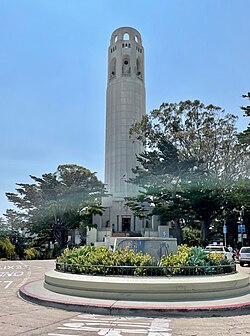Coit Memorial Tower | |
 View of Coit Tower in August 2021 | |
| Location | 1 Telegraph Hill Blvd. San Francisco, California |
|---|---|
| Coordinates | 37°48′09″N 122°24′21″W / 37.80250°N 122.40583°W |
| Area | 1.7 acres (0.69 ha) |
| Built | 1933 |
| Architect | Arthur Brown Jr., Henry Temple Howard |
| Architectural style | Art Deco |
| NRHP reference No. | 07001468[1] |
| SFDL No. | 165 |
| Significant dates | |
| Added to NRHP | January 29, 2008 |
| Designated SFDL | 1984[2] |
Coit Tower (also known as Coit Memorial Tower) is a 210-foot (64 m) tower in the Telegraph Hill neighborhood of San Francisco, California, overlooking the city and San Francisco Bay. The tower, in the city's Pioneer Park, was built between 1932 and 1933 using Lillie Hitchcock Coit's bequest to beautify the city of San Francisco. It was added to the National Register of Historic Places on January 29, 2008.[1]
The Art Deco tower, built of unpainted reinforced concrete, was designed by architects Arthur Brown Jr. and Henry Temple Howard. The interior features fresco murals in the American Social Realism style, painted by 22 different onsite artists and their numerous assistants. Three artists preferred oil on canvas and worked offsite. One artist preferred egg tempera rather than fresco.
It is often erroneously stated that the structure was dedicated to the volunteer firemen who had died in San Francisco's five major fires, but that is not accurate. The tower was constructed as the result of a bequest by Lillie Hitchcock Coit, whose will included two bequests, one to create a memorial to the city's volunteer firefighters, which was done by statuary in Washington Square, and the other to beautify the city. Coit Tower is the result of the second bequest.[3] A concrete relief of a phoenix by sculptor Robert Boardman Howard is placed above the main entrance. It was commissioned by the architect and cast as part of the building.[4]
Although an apocryphal story claims that the tower was designed to resemble a fire hose nozzle[5] due to Coit's affinity with the San Francisco firefighters of the day, the resemblance is coincidental.[6]
- ^ a b "National Register Information System". National Register of Historic Places. National Park Service. July 9, 2010.
- ^ "City of San Francisco Designated Landmarks". City of San Francisco. Archived from the original on 2014-03-25. Retrieved 2012-10-21.
- ^ Robert W. Cherny, The Coit Tower Murals: New Deal Art and Political Controversy in San Francisco (2024), ch. 1
- ^ "Oral history interview with Robert Boardman Howard". Archives of American Art. September 16, 1964. Retrieved November 19, 2022.
- ^ Crowe, Michael F. and Robert W. Bowen (2007). Images of America: San Francisco Art Deco. Arcadia Publishing. p. 72. ISBN 978-0-7385-4734-3.
- ^ "Coit Tower". San Francisco Recreation & Parks Department. Retrieved September 8, 2014.
Contrary to popular belief, Coit Tower was not designed to resemble a firehose nozzle.


